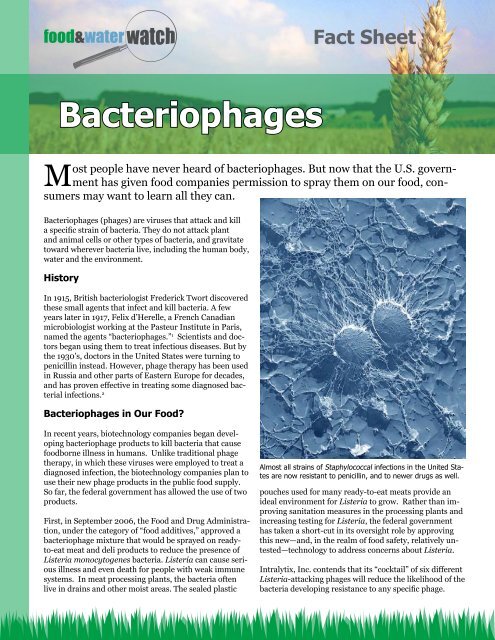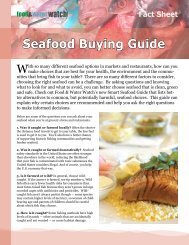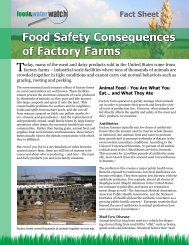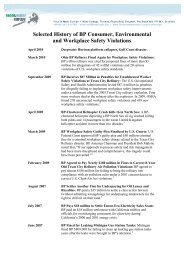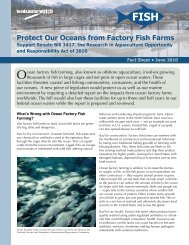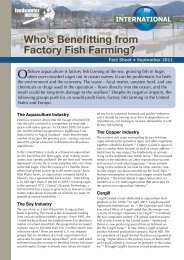Bacteriophages - Food & Water Watch
Bacteriophages - Food & Water Watch
Bacteriophages - Food & Water Watch
Create successful ePaper yourself
Turn your PDF publications into a flip-book with our unique Google optimized e-Paper software.
Fact Sheet<br />
<strong>Bacteriophages</strong><br />
Most people have never heard of bacteriophages. But now that the U.S. government<br />
has given food companies permission to spray them on our food, consumers<br />
may want to learn all they can.<br />
<strong>Bacteriophages</strong> (phages) are viruses that attack and kill<br />
a specific strain of bacteria. They do not attack plant<br />
and animal cells or other types of bacteria, and gravitate<br />
toward wherever bacteria live, including the human body,<br />
water and the environment.<br />
History<br />
In 1915, British bacteriologist Frederick Twort discovered<br />
these small agents that infect and kill bacteria. A few<br />
years later in 1917, Felix d’Herelle, a French Canadian<br />
microbiologist working at the Pasteur Institute in Paris,<br />
named the agents “bacteriophages.” 1 Scientists and doctors<br />
began using them to treat infectious diseases. But by<br />
the 1930’s, doctors in the United States were turning to<br />
penicillin instead. However, phage therapy has been used<br />
in Russia and other parts of Eastern Europe for decades,<br />
and has proven effective in treating some diagnosed bacterial<br />
infections. 2<br />
<strong>Bacteriophages</strong> in Our <strong>Food</strong>?<br />
In recent years, biotechnology companies began developing<br />
bacteriophage products to kill bacteria that cause<br />
foodborne illness in humans. Unlike traditional phage<br />
therapy, in which these viruses were employed to treat a<br />
diagnosed infection, the biotechnology companies plan to<br />
use their new phage products in the public food supply.<br />
So far, the federal government has allowed the use of two<br />
products.<br />
First, in September 2006, the <strong>Food</strong> and Drug Administration,<br />
under the category of “food additives,” approved a<br />
bacteriophage mixture that would be sprayed on readyto-eat<br />
meat and deli products to reduce the presence of<br />
Listeria monocytogenes bacteria. Listeria can cause serious<br />
illness and even death for people with weak immune<br />
systems. In meat processing plants, the bacteria often<br />
live in drains and other moist areas. The sealed plastic<br />
Almost all strains of Staphylococcal infections in the United States<br />
are now resistant to penicillin, and to newer drugs as well.<br />
pouches used for many ready-to-eat meats provide an<br />
ideal environment for Listeria to grow. Rather than improving<br />
sanitation measures in the processing plants and<br />
increasing testing for Listeria, the federal government<br />
has taken a short-cut in its oversight role by approving<br />
this new—and, in the realm of food safety, relatively untested—technology<br />
to address concerns about Listeria.<br />
Intralytix, Inc. contends that its “cocktail” of six different<br />
Listeria-attacking phages will reduce the likelihood of the<br />
bacteria developing resistance to any specific phage.
Then, in January 2007, the U.S. Department of Agriculture<br />
also approved a bacteriophage product that<br />
OmniLytics Company designed to be sprayed, misted<br />
or washed onto cattle hides to reduce the presence of E.<br />
coli bacteria. But this does not address the source of the<br />
problem, for the bacteria start out living in cattle intestines.<br />
They then pass through the digestive tract and out,<br />
into the manure. Inside today’s industrial factory farms,<br />
the animals are packed together amidst the mucky mixture<br />
of manure and water, so it is no surprise that E. coli<br />
are splashed onto their hides. From there, the bacteria<br />
can contaminate the meat supply if the hide touches muscles<br />
and organs during slaughter. Rather than spraying<br />
an inadequately tested product, a better solution to E. coli<br />
and other bacterial contamination would be to eliminate<br />
factory farms and instead raise cattle on pasture.<br />
In addition to the two products described above, Intralytix,<br />
Inc. and OmniLytics are developing other phage<br />
products to be used in food, water and agriculture. Based<br />
on the recent decisions, the government likely will approve<br />
them.<br />
Concerns with <strong>Bacteriophages</strong> in<br />
the <strong>Food</strong> Supply<br />
Limited Safety Testing<br />
The FDA and USDA did not conduct thorough safety<br />
testing on the widespread introduction of bacteriophage<br />
products into the food supply. While medical practitioners<br />
have long employed them to fight bacterial infections,<br />
they have done so for a diagnosed condition to be<br />
treated within a finite period. Now, however, the pharmaceutical<br />
industry would expose consumers to these<br />
products via the food supply on a daily basis.<br />
In the petition for government approval of bacteriophage<br />
preparation as a food additive, Intralytix, Inc. submitted<br />
only one unpublished study, conducted by their researchers,<br />
showing that the product reduced the presence of<br />
Listeria in meat. No independent, peer-reviewed feeding<br />
studies were conducted. These products should have<br />
undergone more thorough safety testing before receiving<br />
approval.<br />
Resistance<br />
Bacteria can and do, after repeated exposure to low levels<br />
of antibiotics routinely fed to livestock on large factory<br />
farms, develop resistance. When these bacteria reproduce,<br />
they spread the resistance trait. The American<br />
Medical Association, American Public Health Association,<br />
and the National Institutes of Health all describe<br />
antibiotic resistance as a growing public health concern. 3<br />
Almost all strains of Staphylococcal (Staph) infections in<br />
the United States are now resistant to penicillin, and to<br />
newer drugs as well. 4<br />
Based on conversations with microbiologists, <strong>Food</strong> &<br />
<strong>Water</strong> <strong>Watch</strong> is concerned that the widespread use of<br />
bacteriophages in the human food supply could result in<br />
bacteria becoming resistant to bacteriophage treatments.<br />
Intralytix, Inc. tried to address this concern by including<br />
six different phages specific to Listeria in their product.<br />
In its approval of the product, the FDA described the<br />
company’s “rationale for incorporating multiple phages<br />
in one formulation is to minimize the possibility of L.<br />
monocytogenes developing a resistance to the additive.” 5<br />
However, this raises the question of whether bacteria<br />
eventually will develop resistance in spite of the multiple<br />
phages. And how will we know?<br />
Labeling<br />
Consumers have the right to know which meat products<br />
have been treated with bacteriophages and which have<br />
not. As it stands now, unfortunately, the only way of<br />
knowing whether foods contain them would be to look<br />
for the words “bacteriophage preparation” buried in the<br />
ingredient list. The government does not require the<br />
companies to clearly and prominently label these products<br />
– the more effective way to inform consumers.<br />
The <strong>Food</strong> and Drug Administration and U.S. Department<br />
of Agriculture should require clear labeling—not the fine<br />
print—so that consumers can make informed choices<br />
about food.<br />
Endnotes<br />
1<br />
Pennazio S. “The origin of phage virology.” Rivista di Biologia,<br />
99(1):103-29, Jan-Apr 2006.<br />
2<br />
Khardori N. “Antibiotics--past, present, and future.” Medical Clinics of<br />
North America, 90(6):1049-76, Nov. 2006.<br />
3<br />
“Antibiotics and Antimicrobials.” American Medical Association.<br />
http://www.ama-assn.org/ama/pub/category/1863.html.<br />
“The Problem of Antimicrobial Resistance.” National Institute of Allergy<br />
and Infectious Disease. http://www.niaid.nih.gov/factsheets/antimicro.<br />
htm. April 2006<br />
“Antibiotic Resistance Fact Sheet.” American Public Health Association.<br />
http://www.apha.org/advocacy/reports/facts/advocacyfactantibiotic.<br />
htm.<br />
4<br />
Keep Antibiotics Working. “The Health Threat.” www.<br />
keepantibioticsworking.com.<br />
5<br />
71 Fed. Reg. 47,729, 47,730 (Friday, August 18, 2006).<br />
For more information:<br />
web: www.foodandwaterwatch.org<br />
email: foodandwater@fwwatch.org<br />
phone: (202) 797-6550<br />
Copyright © March 2007 <strong>Food</strong> & <strong>Water</strong> <strong>Watch</strong>


